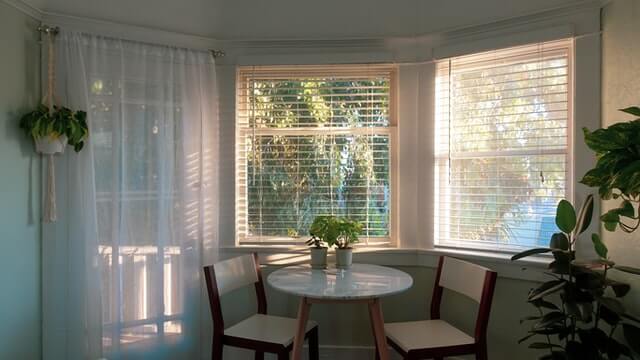Window coverings can add the finishing decorative touches to a room to help create the desired atmosphere and they can also provide privacy from people passing by. Another very practical purpose for window coverings is energy conservation. In places that have long, cold winters letting sunlight in and using window coverings to retain that heat after dark can be an effective way of reducing heating costs.
In other parts of the world where it is mild to hot year-round, the right window coverings can be a crucial way of keeping your house cool so that reduce your air conditioning needs and keep your electric bills down. Another reason to get great window coverings is to protect what you have inside your home. Sunlight can damage furniture, photographs, art and other items that you have inside, but with the right window coverings you can protect your belongings.
Blinds
One of the great things about blinds is that they’re easy to open and close. This convenience enables people to use them regularly as intended because they don’t have to fuss with tying back curtains or worry about wind conditions that may affect the use of an awning.

There are many different types of blinds to choose from. Blinds typically cover the entire window, but they can be adjusted to only extend partway down a window if preferred. Venetian blinds are one example of blinds that can be adjusted to allow sunlight through or block it out. Those who wish to shield their home from excessive sunlight can consider timber blinds in Brisbane, which are designed to let homeowners control light flow. It is important to look at local producers or companies that have developing products with climate demands in mind, because some materials will not withstand prolonged exposure to the heat.
Other types of blinds include: panel blinds, which are long blinds that do not extend down but are drawn along a track from one side of your window to the other; Roman blinds, which do not have openings between slats but can be extended down in blocks to partially or fully cover your windows; and roller blinds, which are one prolonged coverings that can be rolled down to shield part or all of your window.
Curtains
Curtains are typically made of fabric and hang along rods above windows. Sometimes people use light, translucent curtains as a way of offering a little bit of privacy but still allowing sunlight in. Others may be looking for heavy curtains that help trap the heat inside or keep the heat out.
It is important to consider the material of the curtains to determine if it suits your needs. Thicker curtains will be more effective if your goal is to control heat flow and protect your belongings from damage from sunlight. Another factor to consider is color. If your goal is to limit heat from the sunlight you will want light-colored drapes.
Curtains can let wind into your home if you have your windows open. This has benefits and disadvantages. They can let you strike a balance between keeping the sun out and letting the cool air in the morning or evening; however, if they are light enough the wind could displace them, allowing more sunlight into your home than you intend.
Awnings and shutters
Awnings are external coverings. Research shows they can reduce heat from the sun by as much as 77 percent, depending on the direction the windows face. This is an important consideration for people who live in places that are hot most of the year or regularly experience extreme heat during summer months. Deluxe awnings also cover sunrooms and outdoor seating areas.

Shutters can be used for both doors and windows. They cover the entire opening from top to bottom and side to side. One of the nice things about shutters is that they are designed to stay in place and look nice. They won’t be blown by the wind. Shutters can be solid or they can be designed to allow strips of light through. Homeowners should consider their energy needs to choose the right shutters for their home.
One of the drawbacks with awnings is that they can be susceptible to wind damage. It is important to consider all local weather variables to determine if awnings are the most ideal way to shield your home from sunlight or if they should be used in combination with other window coverings.







